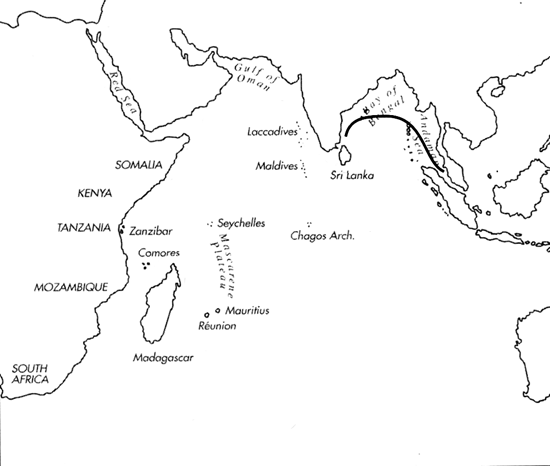Range: E. India to Andaman Sea.
Description: Medium-sized to moderately large, moderately solid. Last whorl conical, outline almost straight; subadult shells slightly convex adapically, large shells with a concave right side. Shoulder sharply angulate. Spire of moderate height, early whorls stepped, outline regularly concave. Larval shell of about 2 whorls, maximum diameter 0.8-0.9 mm. First 5-7 postnuclear whorls tuberculate, later whorls carinate. Teleoconch sutural ramps flat to slightly concave, with pronounced closely set radial threads; early ramps with 1-2 increasing to 3 fine spiral grooves, later ramps with finer spiral striation. Last whorl with a few spiral grooves at base, separated by ribs anteriorly and by ribbons posteriorly.
| Shell Morphometry | ||
|---|---|---|
| L | 36-65 mm | |
| RW | 0.11-0.22 g/mm | |
| RD | 0.55-0.58 | |
| PMD | 0.87-0.96 | |
| RSH | 0.13-0.19 | |
Ground colour white, suffused with violet and cream on last whorl. Last whorl with fawn axial streaks, varying from separate to fused in an almost solid brown colouration. Larval whorls white. Early teleoconch sutural ramps usually tan, later ramps grade to largely white. Aperture cream white, shaded with very pale violet.
Habitat and Habits: Reported from about 50 m.
Discussion: C. capreolus is similar in shape to C. bayani, C. volurninalis, C. generalis, C. rnaldivus, and C. monile. C. bayani differs in its variously shaped axial pattern elements as well as the presence of spiral rows of brown dashes on the last whorl, in its brown (vs. white) larval shell, white (vs. brown) early teleoconch sutural ramps and its abruptly projecting apex (vs. gradually rising spire). It has the first 5-8 postnuclear whorls with smaller and more tubercles (see Rockel, 1985a). For distinctions from the other species, see their Discussions. The holotype of C. semisulcatus Sowerby III (Pl. 70, Figs. 4,5) is a juvenile and faded specimen without locality but with the subsequently added statement "Bay of Bengal, off Ceduba Isl. (Investigator)" on the original label. This island is located S. of Sittwe at the coast of Burma, within the geographical range of C. capreolus. C. semisulcatus has a slightly broader last whorl (RD 0.60) than C. capreolus from India and W. Thailand, but cannot be distinguished morphometrically otherwise. Therefore, we assign C. semisulcatus to C. capreolus. Other authors synonymized C. semisulcatus Sowerby I11 with C. rutilus (Walls, [1979], da Motta, 1987) or with C. articulatus (Cernohorsky, 1978); Richard (1990) considered it a valid species.

C. capreolus range map
This section contains verbatim reproductions of the accounts of 316 species of Conus from the Indo-Pacific region, from Manual of the Living Conidae, by Röckel, Korn and Kohn (1995). They are reproduced with the kind permission of the present publisher, Conchbooks.
All plates and figures referred to in the text are also in Röckel, Korn & Kohn, 1995. Manual of the Living Conidae Vol. 1: Indo-Pacific Region.
The range maps have been modified so that each species account has it own map, rather than one map that showed the ranges of several species in the original work. This was necessary because each species account is on a separate page on the website and not confined to the order of accounts in the book.